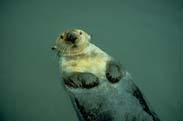Oceans
Habitat code: 420
 Photo: KMD |
 Photo: KMD |
 Killer whale Orcinus orca Photo: KMD |
Distribution and Habitat: Killer whales are found along the Pacific Northwest coastline and sometimes visit Puget Sound. They live in family groups. Diet: Interesting fact: |
 Red sea urchin Strongylocentrotus franciscanus Photo: KMD |
Distribution and Habitat: Sea urchins are found along the tide pools. Diet: Interesting fact: |
 Sea otter Enhydra lutris Photo: GV |
Distribution and Habitat: Sea otters are found along the Pacific Ocean coastline from northern California to Russia. Diet: Interesting fact: |
 Seaweed Photo: JM |
Distribution and Habitat: There are many different types of seaweed. They are found along the shallow areas along shorelines around the world. Interesting fact: |
 Glaucous-winged gull Larus hyperboreus Photo: KMD |
Distribution and Habitat: They are found across North America. Diet: Interesting fact: |